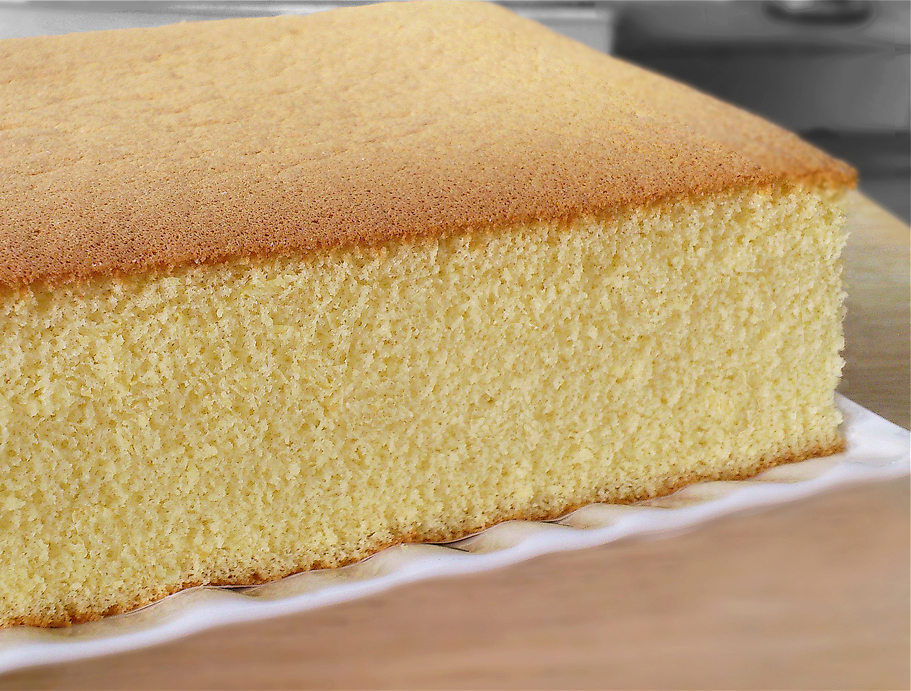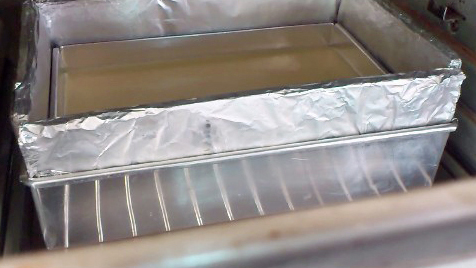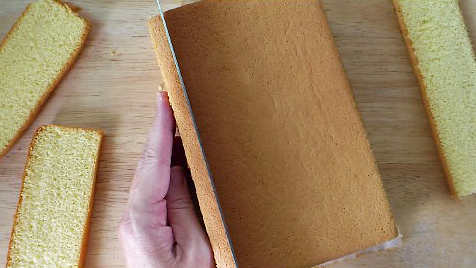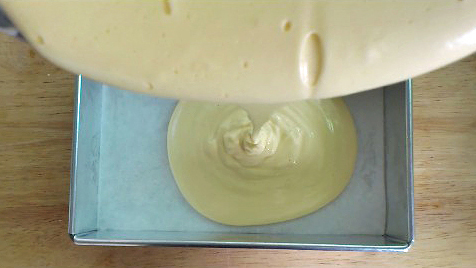Honey Castella Cake

Traditionally, Castella cake is baked in a topless and bottomless wooden frame. With 4 sides insulated with wood, the batter is heated mainly from the top and bottom. This allows the cake to create its signature brown, flat and wrinkle-free crust.
I don’t have a wooden mould, so I improvise. I put the pan holding the batter in a bigger pan, and there’s corrugated cardboard tucked between the two pans. To prevent the cardboard from catching fire in the oven and then burning down the house, I wrap it in foil.
My Castella cake is fluffy and moist freshly baked. I don’t have to wrap it in plastic for a day before eating it. Nope, I don’t cheat by adding oil or an emulsifier. Neither do I sneak plain or cake flour into the cake. I use bread flour, as I’m supposed to.
How do I make a stellar Castella cake?
I start by beating egg whites and sugar till firm peak stage. Once the meringue is firm yet smooth and creamy, I add egg yolks one by one. This method makes an egg foam that’s very stable.
There is, of course, honey in honey Castella cake. How much? Just 20 g, enough to flavour the cake but not make it sticky. Honey is whisked into the batter after the egg yolks. After honey comes flour.
Castella cake must be made with bread flour. Otherwise, it wouldn’t be as springy as it should be. And the crust wouldn’t be as brown and smooth
The last thing added to the batter is milk. As I fold it into the other ingredients, I bang the mixing bowl against the worktop from time to time to help remove big air bubbles.
Halfway through the mixing, I let the batter rest for a few moments. Perhaps thinking the coast is clear, some unsuspecting air bubbles rise to the surface. And that’s when I nap ’em. BANG! BANG! I’m so sneaky, yah?
Transferring the batter into the cake pan gives me another chance to catch those nasty bubbles. I pour slowly, so that some of the big bubbles burst as they flow out of the bowl.
What do I do before the pan goes in the oven?
Yup, bang bang again! It’s zero tolerance for Castella cake’s #1 enemy.
After the cake is done baking, I drop the pan from 1 foot high to stop it from shrinking excessively as it cools down. This is the neatest tip I’ve ever come across in cake making!
Here’s another great tip:
Invert the pan and let it rest on a wood chopping board for a few moments. This stops the top crust from wrinkling.
Just before serving, trim the cake’s edges. The cuts must be neat and clean or you’ve failed even if the cake is perfect in every other way.
Baking a Castella cake is a quest for perfection. I hope you’re the obsessive-compulsive type?

Honey Castella Cake
Video
Ingredients
- 85 g egg whites
- 60 g castor sugar
- 60 g egg yolks
- 20 g honey
- 60 g bread flour
- 20 g full-fat milk
Instructions
- Cut 5 mm thick corrugated cardboard to fit 4 sides of 23 x 15 cm cake pan. Wrap tightly in aluminium foil, shiny side facing out. Line 4 sides of cake pan with cardboard.
- Cut parchment paper to fit bottom of 20 x 12 x 5 cm cake pan. Grease lightly with vegetable oil. Place paper in cake pan, oiled side up.
- Preheat oven to 160°C.
- Whisk egg whites till bubbles are very small. Gradually add castor sugar whilst still whisking. Continue to whisk till firm (not stiff) peak stage, reducing speed towards the end to remove big air bubbles and prevent overwhisking.85 g egg whites, 60 g castor sugar
- Add yolks to whisked egg white in 4 batches. Whisk on low speed till evenly mixed after each addition.60 g egg yolks
- Add honey. Repeat whisking as before.20 g honey
- Sift half of bread flour into batter. Mix with whisk till almost even. Sift remaining flour. Mix till just even.60 g bread flour
- Drizzle milk around bowl. Whisk, skimming just top part of batter, till you don’t see any milk.20 g full-fat milk
- Scrape down and fold with spatula, banging bowl against worktop from time to time, till everything is just evenly mixed. Let batter rest 10 seconds or so midway, then bang bowl against worktop.
- Pour batter into lined cake pan, slowly and from about 30 cm high so that air bubbles burst as they flow out of bowl. Tap pan against worktop 3-4 times. Place in bigger cake pan prepared earlier.
- Bake in bottom of oven till cake is brown and makes a soft squishing sound when pressed lightly, about 35 minutes. (If squishing is loud, cake is still too wet. If there’s no sound at all, cake is overbaked and too dry.)
- Remove pans from oven. Remove cardboard and outer pan. Drop smaller cake pan from about 30 cm high, 2-3 times. Wait a few moments till top of cake starts to wrinkle slightly. Invert pan onto wooden chopping board. Wait till top of cake is flat and smooth, about 30 seconds. Re-invert pan. Leave on wire rack till cool. Unmould, trim edges, cut and serve.
- Cake is best eaten on day it’s made, especially if it’s cut. If serving the next day, or if cake is overbaked, wrap in plastic whilst still warm and unmoulded, till serving time.